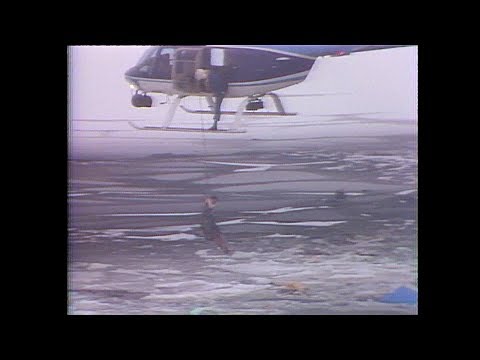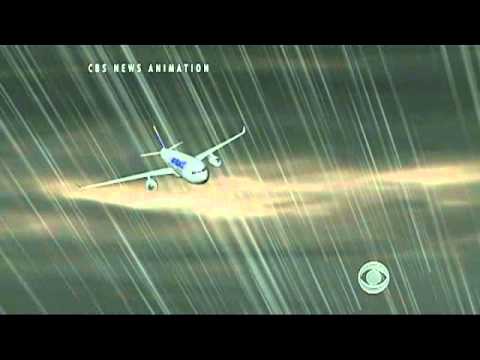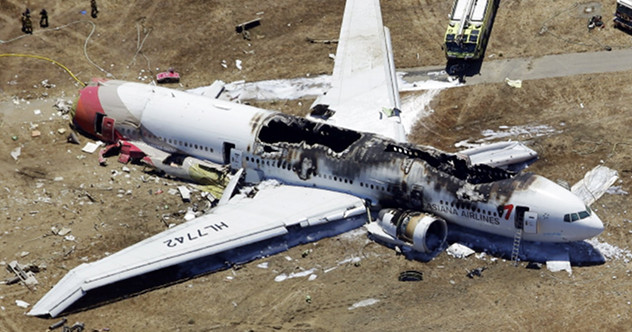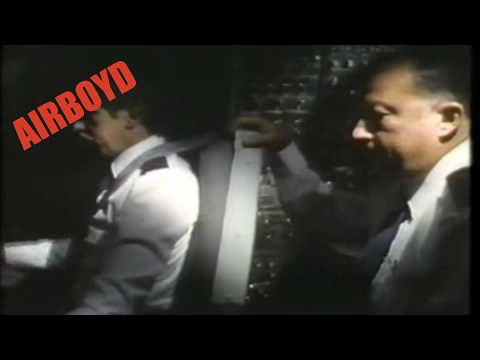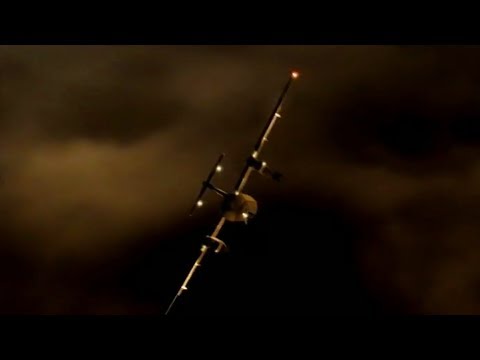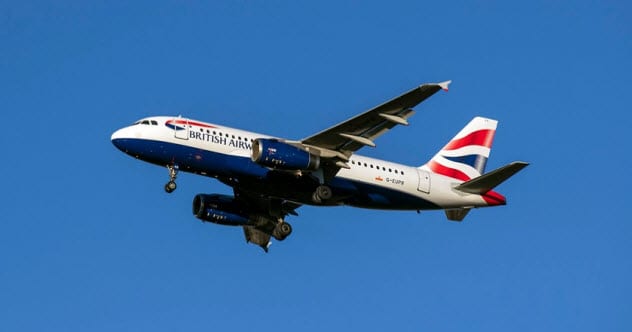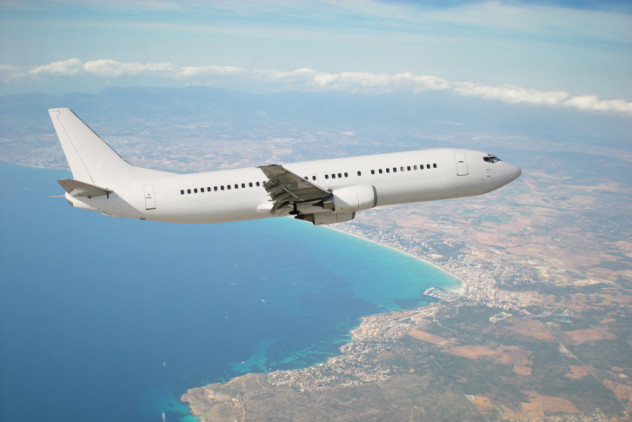Well yeah, unless he doesn’t de-ice the wings before takeoff. Or gets disoriented and thinks the ocean is the horizon. Or misses the runway at landing. Or… Here are ten ways that pilot might kill us all. Please brace for impact. 10 Unbelievable Things That Happened On Airplanes
10 By Never Even Getting on the (Right) Runway
It takes a special pilot to get passengers killed before even attempting a takeoff. On December 3, 1990, at Detroit’s Wayne County Airport, Northwest Airlines Flight 1482 – piloted by Captain William Lovelace and First Officer James Schifferns – was set to depart from Pittsburgh with 40 passengers. The day was notable for its dense, low-hanging fog, but nothing the DC-9 couldn’t quickly outclimb. Departing its gate, Flight 1482 headed for Runway 03C… but instead turned onto another taxiway. To correct the error, they were instructed to make a right to double back. Apparently not satisfied with one dumb mistake, Lovelace and Schifferns instead somehow managed to turn directly onto the active runway. They realized the mistake and contacted air traffic control, who (duh) told them to leave the runway immediately. Five seconds later, Northwest Flight 299, a Boeing 727 taking off en route to Memphis, came barreling toward them. The 727’s wing sliced through the right side of Flight 1482, cutting through the fuselage just below the windows. It then chopped off the DC-9’s right engine. Flight 299’s pilot – who, it must be said, performed phenomenally – initiated a rejected takeoff, and stopped the aircraft safely. Its 146 passengers and 8 crew were all unhurt. The DC-9 caught fire and was destroyed. Seven passengers and one flight attendant died, with another 10 seriously injured. In addition to Lovelace’s culpability, the ensuing investigation criticized the airport’s control tower for “failure to use progressive taxi instructions in low visibility.”
9 By Forgetting to De-Ice the Wings in a Snowstorm
Making sure ice hasn’t accumulated on an airplane’s wings is such a crucial and common occurrence that, even back in the comparably cowboyish 1980s, commercial cockpits contained clearly marked Ice Protection Systems. Unfortunately, Captain Larry M. Wheaton managed to overlook this standard pre-flight checklist item despite more than 8,000 hours of airtime under his belt… and despite the fact that it was snowing. On the afternoon of January 13, 1982, Washington DC’s National Airport was just reopening after a deluge of the same white stuff currently accruing on the wings of Wheaton’s Air Florida Flight 90, bound for Fort Lauderdale with 74 passengers. The experienced pilot he was, Wheaton recognized his error shortly after leaving the gate. But instead of returning for proper de-icing, he and First Officer Roger Pettit had a novel idea: to use the exhaust from the plane ahead of them in the takeoff queue to defrost the wings. How resourceful. The shockingly unsound judgment didn’t stop there. Wheaton decided to proceed with takeoff even after his impromptu de-icing attempt predictably failed—AND after detecting a power problem while taxiing. Flight 90 took off and began climbing… to about 350 feet. Then it lost lift. The Boeing 737 dropped from the sky and slammed into an overpass before plunging into the Potomac River. Seventy passengers and four crew members died, including both pilots. Four motorists on the ground also were killed. Only five survivors were plucked by helicopter from the frigid river, though as many as 19 likely survived the initial crash.
8 By Turning the Plane into a High-speed Bus
On August 20, 2008, Captain Antonio Garcia Luna and First Officer Francisco Javier Mulet did everything right, then everything wrong. Unfortunately, the latter was irredeemable. SpanAir Flight 5022 was a McDonnell Douglas MD-82 carrying 166 passengers and six crew from Barcelona to Madrid. It was scheduled to leave an hour earlier than it did, as the pilots had wisely abandoned a departure due to an excessive reading from the ram air temperature (RAT) probe. The aircraft was taken to a parking area, where maintenance workers deactivated the RAT probe’s heater, which was fine since no ice buildup would occur on a fair-weather August day in Spain. Then Luna and Mulet BOTH forgot to deploy the flaps and slats required for takeoff. Without these “high-lift” devices, the wings could not generate enough lift to keep the aircraft airborne. It didn’t help that the warning system malfunctioned, failing to alert the crew of their mission-critical mistake. Flight 5022 left the ground momentarily, rolled sharply to the right, and smashed into the ground beside the runway. The wings separated and the fuselage snapped into two parts, the larger of which was engulfed by fire. The asinine accident killed 154 people. Only 18 survived.
7 By Not Being in the Cockpit
On June 1, 2009, Air France Flight 447 took off from Brazil’s Rio de Janeiro Airport en route to Paris. The Airbus A330 was carrying 216 passengers and 12 crew – including three flight-trained officers rather than the typical two. The flight comprised 13 hours of duty, and Air France’s policy was that pilots can serve no more than ten hours before taking a break. The extra First Officer allowed for two qualified personnel to fly the plane at all times. Captain Marc DuBois took the mid-flight break shift, while the plane was over the Atlantic Ocean. Just 15 minutes later, First Officer David Robert summoned him back. During his brief absence, the plane had entered turbulent airspace and was also accruing wing ice. The plane had begun to stall, and the two pilots – neither of whom were captains – reacted incorrectly. Just before DuBois reentered the cockpit, co-First Officer Pierre-Cédric Bonin exclaimed: “[Expletive] I don’t have control of the airplane any more now!” DuBois’ first words upon returning were not encouraging. Noticing the various alarms going off, he asked, “er… what are you (doing)?” The aircraft had its nose above the horizon but was descending steeply. Soon after this, Robert said “climb” four consecutive times. Bonin replied, “But I’ve been at maximum nose-up for a while!” When Captain Dubois heard this, he realized Bonin was causing the stall, and shouted, “No, don’t climb! No! No! No!” Flight 447 crashed into the ocean, killing everyone aboard. Had a Captain-level pilot been in the cockpit, it never would have happened.
6 By the Co-Pilot Hitting One Wrong Button
It should be far harder to kill 264 people than 26-year-old First Officer Chuang Meng-jung’s simple error. On April 26, 1994, he and Captain Wang Lo-chi were in the home stretch of China Airlines Flight 140 from Taipei, Taiwan to Nagoya, Japan. The flight had been uneventful, and the Airbus A300 was descending into Nagoya on time and at a safe angle. That all changed just three miles from the runway. At an altitude of 1,000 feet, First Officer Meng-jung inadvertently selected the takeoff/go-around setting, which at that height is instructing the plane’s aircraft’s autopilot to increase the throttles for a second pass at an landing. The crew reacted by manually reducing the throttles and pushing the yoke forward. But the autopilot, acting on the inadvertent go-around command, countered by increasing its own efforts to overcome the pilot’s actions. It moved the horizontal stabilizer to a full nose-up position. Still unaware of the autopilot’s go-around command, the crew then independently decided to go-around. The result was a compounded action that raised the plane’s nose far too high. The steep pitch caused an aerodynamic stall, and Flight 140 dropped like a brick. Only seven of the plane’s 271 occupants lived.
5 By Crashing into Another Bad Pilot in Midair
What are the chances, right? Well apparently, up until the mid-1950s they were quite good. Then one collision led to much-needed changes. On June 30, 1956, a TWA Super Constellation and a United DC-7, carrying a combined 128 people, collided over the Grand Canyon in Arizona at 21,000 feet. The TWA plane’s tail was sheared off, while most of the United flight’s left wing was severed. The TWA Super Constellation plunged in a near-vertical dive, crashing onto a plateau 300 feet above the Colorado River. The United DC-7 sputtered another mile or so before slamming into a butte and careening into a rugged gulch. Everyone perished. It doesn’t seem difficult for two planes to avoid each other in the air (especially in the less crowded skies of the mid-20th Century), but such midair massacres had become a trend. A 1956 “Aviation Week” article noted that, between 1948 and 1955 there were 127 midair collisions in the US, 30 of which involved commercial airliners. In the aftermath of the TWA-United disaster, investigators determined that, although the pilots had simply failed to see each other (really? HOW?), America’s antiquated air traffic control system was also a factor. Fallout from the accident led directly to the 1957 formation of the Federal Aviation Administration and the National Transportation Safety Board.
4 By Getting Distracted By a Spent Lightbulb
It‘s a bit harsh to call the crew of Eastern Airlines Flight 401 dim bulbs, but this might be the flat-out stupidest reason a commercial airliner ever crashed. On December 29, 1972, Flight 401 – a Lockheed TriStsr carrying 163 passengers and 13 crew members from NYC’s John F. Kennedy Airport – was beginning its approach into Miami. Upon lowering the landing gear, First Officer Albert Stockstill noticed that the gear indicator – a green light confirming the nose gear is locked in place – had not illuminated. There were three trained commercial aviators on the flight: First Officer Stockstill, Flight Engineer Donald Repo, and Captain Robert Loft, a 32-year veteran. Loft told the Miami flight tower about the landing gear situation, and received permission to go into a holding pattern at 2,000 feet. He sent Repo down to the avionics bay to report on the landing gear’s position, then told Stockstill to engage the autopilot while they removed the light assembly. Only the autopilot was on the wrong setting. Instead of circling at a steady altitude, it descended so gradually that noone noticed until the plane crashed into the Everglades. Loft’s final words, recorded 10 seconds before the crash, were “Hey, what’s happening here?” Oh nothing, Captain. You’re just getting everyone killed because none of the three pilots are looking out the goddamned window. 101 people died. The landing gear indicator issue was later determined to be a simple burned-out bulb. And even if it wasn’t, the gear could have been lowered manually.
3 By Blowing the Beginning of the Landing
Despite the comparative complexity of the landing process, modern cockpit instruments significantly simplify its execution, making both approach and touchdown as automated as possible. Such tools have helped make air travel the safest means of transportation. Unless, of course, the pilot misuses them. On February 9, 2009, Captain Marvin Renslow and a scarily young First Officer, 24-year-old Rebecca Shaw, were beginning their descent into Buffalo, New York on Colgan Air Flight 3407 from Newark, New Jersey. The Bombardier Dash-8 was carrying 49 passengers – a packed flight for the relatively small commercial aircraft. Upstate New York is frigid in winter, and the airline’s policy called for landings to be performed manually in conditions likely to cause ice accumulation on wings. Despite this, Renslow kept the plane on autopilot as it slowed for landing. And slowed. And slooowed… until the shaker stick, a warning system intended to jolt the pilot to attention, warned of an impending midair stall. Renslow – who should have already been manually guiding the aircraft – responded by abruptly pulling back on the control column and increasing thrust to 75% power – neither of which was right. The proper stall recovery technique is lowering the nose and applying full power. Flight 3407 pitched up, down, left and then rolled violently right. It crashed into a house and burst into flames, killing everyone on board and one on the ground. Notably, the flight became a rallying call for pilots to receive more rest between flights, as fatigue was among the factors blamed for Renslow’s deadly mistakes.
2 By Blowing the Middle of the Landing
Nearly half of all fatal crashes happen during final descent and landing, by far the most dangerous leg. As the plane descends, the most important job for a pilot is to ensure the aircraft’s angle and alignment head directly onto the runway. On September 27, 1977, the captain of Japan Airlines Flights 715 was attempting to do just that as the plane approached Malaysia’s Sultan Abdul Aziz Shah Airport. The weather was poor, so Flight 715 was on a VOR approach, which provides lateral guidance until the plane reaches its MDA, or Minimum Descent Altitude. From there, pilots are instructed to maintain that altitude until the runway comes into view. The idea is to get below the cloud cover – but not so far below that the aircraft is endangered. Flight 715’s MDA was 750 feet. Landing gear down and flaps extended, the DC-8 jet dropped to 750 feet. Then it kept dropping. At 300 feet, it crashed into a hill four miles from the airport. The plane broke apart and burst into flames. Incredibly, only 34 of the 79 people aboard perished. The cause of the crash was simple: the pilot descended below his minimum descent altitude without having the runway in sight. Instead of aborting the approach and circling back, the pilot took the plane to a height of a medium-sized Manhattan office building. Investigators also blamed the First Officer for doing nothing to stop this flagrant procedural violation.
1 By Blowing the End of the Landing
Plenty of deadly crashes occur just as planes touch down – typically because they over- or under-shoot the runway. However, a deadly landing accident last year occurred for an especially unusual reason. On May 22, 2020, Pakistani International Airlines Flight 8303 was descending into Karachi from Lahore, carrying 91 passengers and eight crew members. The Airbus A320’s descent was abnormally abrupt, unnerving air traffic controllers as the plane approached the runway. Then “unnerved” turned to “mortified.” Captain Sajjad Gul and First Officer Usman Azam were about to land without landing gear despite the multitude of procedures and warnings designed to prevent exactly that. “It is unbelievable to me that an airline crew on a jet like an Airbus, with all the warning systems, would attempt to land the plane without the gear extended,” said John Cox, an aviation safety consultant. The plane’s two engines grinded along the runway at speeds exceeding 200mph – 40mph faster than an Airbus should land, with or without wheels. Amazingly, the pilots were able to re-ascend away from the airport… but only briefly. The plane lost power (maybe it was that whole engines-grinding-the-pavement-at-high-speeds thing) and crashed into a nearby neighborhood, killing one person on the ground. Only two passengers lived. 10 Most Unexpected Plane-Related Incidents To Happen In Recent Times Read More: Twitter Website

